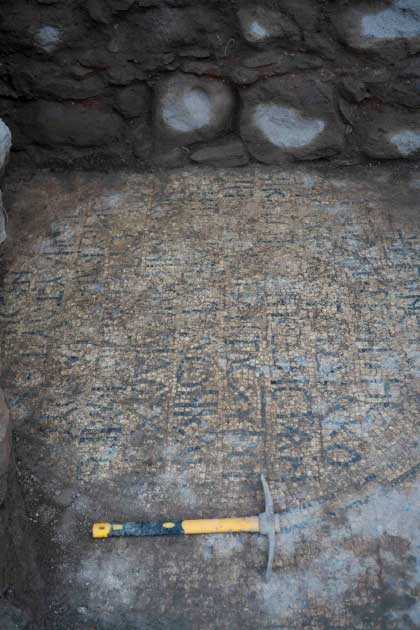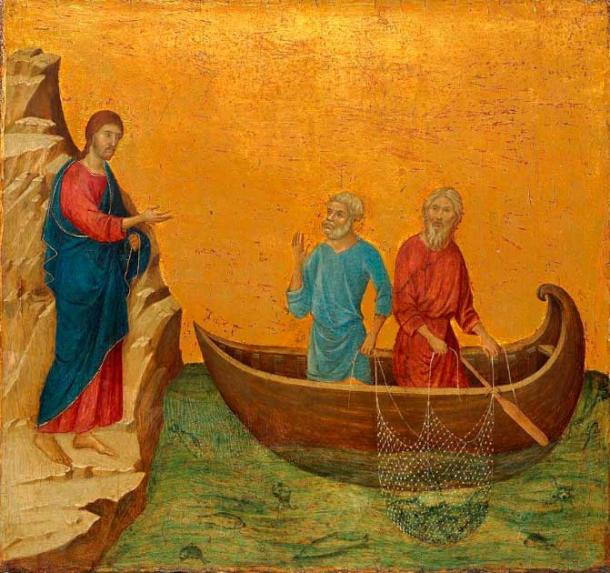Saint Peter, one of Jesus Christ’s 12 Apostles and the first pope of the Roman Catholic Church is a crucial figure whose name appears throughout Christian theology. His birthplace has been a long contested and awaited find, and with it the lost ancient city of Bethsaida (literally meaning, “home of the fishermen”). Now, archaeologists from Israel have found an ancient Greek inscription within a mosaic that was one part of this ancient lost city at modern-day El-Araj, located on the north shore of the Sea of Galilee.

The St. Peter’s inscription within a larger mosaic floor area found on the shores of the Sea of Galilee, famous for some of the “miracles” performed by Jesus. (Zachary Wong / Center for the Study of Ancient Judaism and Christian Origins )
St. Peter’s Inscription Is Revealing and Confirming
The hidden inscription found in the Sea of Galilee mosaic reads as a prayer for intercession to the “chief and commander of the heavenly apostles.” According to the official press statement on the News Wire report from the El Araj Excavation Project team, this is a clear reference to St. Peter that was frequently used by Byzantine Christian writers to allude to Jesus’ first follower and thereby the leader of the Apostles. Fellow “brothers” Saint Andrew and Saint Philip were supposedly born in Bethsaida, according to the Gospel of John.
“One of the goals of this dig was to check whether we have at the site a layer from the 1st century, which will allow us to suggest a better candidate for the identification of Biblical Bethsaida. Not only did we find significant remains from this period, but we also found this important church and the monastery around it,” said archaeologist Mordechai Aviam, archaeological director of the excavation.
The El-Araj Expedition , led by the Kinneret Institute for Galilean Archeology and New York’s Nyack College, has been conducting excavations at one of the sites, the El-Araj dig site, since 2016. The mosaic was first uncovered in 2021 during excavations at a Byzantine-era building on the site, known as “ The Church of the Apostles .”
The mosaic was shielded by layers upon layers of dirt accumulated over 1,500 years, so it took a while before it could be uncovered, reports The Smithsonian . The St Peter’s inscription is within a round medallion with two black lines of tesserae running across each side. It was part of a larger floor-based floral pattern in the church’s sacristy area.

The early 14th-century painting Calling of the Apostles Peter and Andrew by Duccio di Buoninsegna that was originally part of the altar at the Siena Cathedral in Italy showing Jesus calling the apostles Peter and Andreas. (Duccio di Buoninsegna / Public domain )
A Miracle: St Peter’s Birthplace Has Almost Been Revealed!
“This discovery is our strongest indicator that Peter had a special association with the basilica, and it was likely dedicated to him. Since Byzantine Christian tradition routinely identified Peter’s home in Bethsaida, and not in Capernaum as is often thought today, it seems likely that the basilica commemorates his house,” said Steven Notley, academic director of the dig.
[embedded content]
The Byzantine era basilica has been described in the writings of Willibald, an 8th-century German bishop from Eichstadt. Willibald made a holy pilgrimage to this site in 724 AD, and his writings have helped corroborate the identity of the find. In his words “they went to Bethsaida, the residence of Peter and Andrew, where there is now a church on the site of their house.”
The proximity to the Sea of Galilee probably caused Bethsaida to be buried by flooding and disappear from the records. According to Artnet News , this is consistent with the current archaeological record connected to the remains of the church above the Roman bathhouse.
There is a 16 layer inch of silt between them, and the references to Bethsaida disappear around the third century AD, when the potential flooding occurred. A potentially devastating seismic event destroyed and buried the church in 749 AD, according to Haaretz. This led to the loss of the “Church of the Apostles” from historical record after this point.
When the next excavation season begins in October, the archaeologists also hope to find an inscription dedicated to Andrew, since the church would likely have been dedicated to both men.
This will also resolve the debate about Peter’s birthplace, which is mentioned as both Bethsaida and Capernaum in the Bible. Incidentally, Capernaum is also located on the northern shore of the Sea of Galilee, on the western side, whilst Bethsaida is on the east.
Bethsaida means home of the fishermen, and Peter (born Simon Peter) was a fisherman, who abandoned his profession to follow Jesus. In a Live Science report from 2021, Robert Cargill, an archaeologist and professor of Judaism and Christianity at the University of Iowa, said he was confident that el-Araj is Bethsaida. “The case for el-Araj isn’t just convincing; it’s overwhelming and becoming more compelling with each excavation season,” he reasoned.
Top image: Archaeologists pose near the St Peter’s inscription found on the north shore of the Sea of Galilee, Israel, which could finally prove a number of things about the first apostle of Jesus. Source: El Araj Excavation Project
By Sahir Pandey
Related posts:
Views: 0
 RSS Feed
RSS Feed















 August 22nd, 2022
August 22nd, 2022  Awake Goy
Awake Goy  Posted in
Posted in  Tags:
Tags: 
















